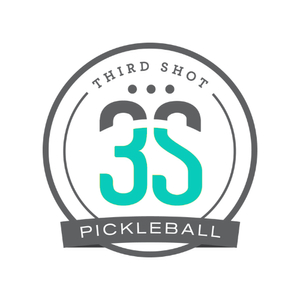When it comes down to it, pickleball is pretty simple: you want to put the ball in play once more than your opponents do. But executing on this is not so straightforward. Sending the ball with the right height, speed, spin, distance and direction, requires excellent control of the paddle. You have to get the vertical and horizontal angles just right, have the paddle moving at the perfect speed and make sure that the swing path is appropriate for the height and spin of the ball you are trying to send. That’s a lot to worry about!
A good impact point is often the difference between making shot or missing it. Bara Sebkova doing a good job here keeping the ball a comfortable distance from her body.
This is why it is so important that players care about having a good impact point. The impact point is where a person makes contact with the ball relative to their body. It exists on three planes: up and down (how high or low the ball is at contact); side to side (how close to or far from your belly button); forward and back (how far between your body and the net when standing sideways).
Why does it matter?
More than virtually anything else, the impact point is is a key contributor to control. With so many variables to consider when hitting the ball, it is important to receive it at a position where those variables can be tweaked. When the ball is close to you — but not too close — it becomes easier to control where you strike it. When the ball is at a comfortable height and you don’t have to bend over, it will be easier to be subtle with your paddle angle or swing path. Good impact points allow us to hit the ball in a place where it is relatively easy to manipulate while being in a strong hitting position.
Megan Fudge makes contact out front (between her body and net) as this is a strong hitting position.
What counts as good?
Generally speaking, we want the ball to be a comfortable distance from our body — not too close that we feel jammed and not too far that we are stretching and off-balance. We also like the impact point to typically be as high as possible. This is true if we are hitting a volley that we would like to put away or hitting a dink or third shot drop or drive. Finally -- and this one is often under-appreciated -- we would like the impact point to be out front between our body and the net. An impact point that is beside us, or behind us puts us in a weak hitting position and will often limit our opportunity to send the shot we want. There are of course exceptions to this, but on the whole, a forward impact point gives the player a better chance to hit a wide variety of shots successfully.
Beth Ballamy setting up for a perfect impact point on her serve.
Rick Witsken takes the ball early, preventing it from getting too close to his body.
What can I do to improve my impact point?
Want to be better at receiving the ball well? Here are a few tips:
Care About It. You are unlikely to improve your impact point if you don’t think it is important. Getting buy-in and is a critical first step.
Think Moving vs Reaching. Strong players focus more on setting up for the ball with their feet than reaching for it with their paddle. You can even practice this without anything in your hand. You can also improve your reception skills by showing a great impact point and having a friend hit the ball. Can you receive it perfect without moving your paddle at all?
Identify Good vs Bad. Each time you hit a ball, you should be able to know whether you received it well. Start being more attentive to this and you’ll find your good impact points will increase.
As your partner sends the ball, prepare your perfect impact point and see if you can move to the right place.
Callie Smith taking the low volley as high as possible.
Conclusion
While it is nice to try to have great impact points the truth is that it is tough. After all, by hitting fast, low, away from you or with spin, your opponents are trying to force a bad impact point. They know you won’t be as good if you’re not in a great hitting position. Your job is to fight for the impact point — to resist their attempt at making you break down. Work hard on your movement, be attentive to where you make contact and above all else, care. Once having a great impact point becomes a priority for you, you’ll be amazed at how often you can have a good one.






